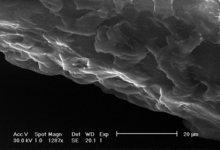Head hair

As head hair are hair on the human head referred to, as opposed to facial hair and other body hair . The human head hair grows at a rate of about 0.3 mm per day. This value depends, among other things, on age, hormone status and ethnicity (Asian hair grows faster, African hair slower).
growth
The scalp hair, like any hair, is subject to a growth cycle at the end of which it falls out and is replaced by a new hair. The lifespan of a hair can vary from person to person. With an average of around 2–6 years, the growth phase (anagen phase) of scalp hair is significantly higher than that of body hair. Cases of a growth phase of more than 20 years have also been documented. Accordingly, there are people with body-length hair, as a rule the hair length is genetically limited to about 1 m.
Hair has an orientation. At the back of the head, for example, they are usually aligned towards the body, while on the top of the head they are towards the forehead . However, many people also have so-called hair swirls , areas in which the hairline is laid out in a circle. This is genetic and can lead to problems with hairdressing.
The hair outside the scalp consists of dried out , cornified cuticle , cortex and medulla cells, only the hair follicles contain living cells. Therefore, damaged hair cannot regenerate itself biologically.
Hair thickness
The average human hair is about 0.05 to 0.08 mm thick. For fine hair , 0.02 to 0.04 is given. With increasing age, the hair becomes thinner due to hormones.

Number of hairs
The number of hairs is related to the ethnicity and age of the person. Europeans have about 226 hairs / cm², while Asians have about 175 hairs / cm² and Africans only about 161 hairs / cm². These values can vary greatly.
This results in roughly the following values for women:
- European women: approx. 121,000 hairs
- Asian women: approx. 89,000 hairs
- African women: approx. 81,000 hairs
A hair loss of around 100 hairs per day is considered normal, this value is slightly lower (around 60 hairs / day) for people of African or Asian ethnicity.
Hair care
Long hair requires care as the tips dry out and split (“ split ends ”). Every form of external friction (e.g. on clothing) is stressful to the hair ; additional stress, e.g. B. Tearing by combing with a plastic comb with tangled or knotted strands of hair can destroy the hair. Alternatively, hand- sawn hard rubber combs are available with rounded prongs that do less damage to the hair than a sharp plastic edge that can even cut the hair.
Broad-pointed combs help detangle the hair. This is necessary so that the hair does not form inextricable dreadlocks over time , which can then no longer be broken down into individual hairs .
Hair wash
Recommended care products after shampooing are rinses ( Engl. Rinsing ) and / or hair balm (Engl. Conditioner ), as these more easily by combing the hair allow. Wet hair is more sensitive than dry hair, so be extra careful when combing through wet hair.
The hair near the scalp , not the hair strand, is shampooed while the conditioner and conditioner are applied to the hair strands; After shampooing, however, the shampoo is washed off with plenty of water over the strands. In order not to irritate the scalp too much, water-thinned shampoos are used; this allows you to wash your hair more often.
The hair dryer should not be set too hot, as overheating the hair will cause the water inside to evaporate and explode out of the hair fibers ; the fiber is destroyed in the process.
If the split ends are visible , the tips are cut off, which prevents further splitting of the hair (at least for the time being).
Hair changes
When you bleach your hair, your own pigments (in the case of dark or colored hair) are destroyed. Bleaching is similar to burning (using hydrogen peroxide ). Bleached hair requires special care: it is easier to tear than natural hair. Bleaching preparations can damage both skin and clothing if used improperly.
Hair problems
Dandruff forms when too many or sticky cells are shed during the scalp renewal process.
Oily hair is attributed to an overproduction of the sebum glands . Possible causes are genetic predisposition, stress or metabolic disorders .
Dry , dull and split hair can be signs of a deficiency in biotin (vitamin H). Biotin is essential for the formation of the horny substance keratin and thus contributes significantly to the healthy growth of skin, hair and fingernails.
literature
- Hans Schöneberg (Hrsg.): The hairdresser book in learning fields. (= Craft and technology. 3935). 3., rework. u. exp. Edition. Craft and technology, Hamburg 2003, ISBN 3-582-03935-8 .
- Nina Bolt: hair. A cultural history of the most important main thing in the world. (= Bastei Lübbe non-fiction book, 60495). Bastei Lübbe, Bergisch Gladbach 2001, ISBN 3-404-60495-4 .
- Jane Campsie: beautiful hair, perfect makeup. Könemann, Cologne 2001, ISBN 3-8290-2296-4 .
- Linda Deslauriers: Hair in the Light. Königsfurt, Krummwisch 2004, ISBN 3-89875-124-4 .
Web links
Individual evidence
- ↑ a b c Trefor Evans, R. Randall Wickett : Practical Modern Hair Science . First edition. Allured Books, 2012, ISBN 978-1-932633-93-1 .
- ^ A b c Clarence R. Robbins : Chemical and Physical Behavior of Human Hair. 5th edition. Springer Verlag, Berlin / Heidelberg 2012, ISBN 978-3-642-25610-3 .
- ↑ Tips for fine hair .
- ↑ Hair care can be very easy. Category: hair care . In: dandruff shampoo. Retrieved June 4, 2014 .
- ↑ LIVOR.de: What kind of care does my hair need? ( Memento from February 22, 2014 in the Internet Archive )
- ↑ paradisi.de: Split ends : Split the ends of the hair.
